
Guests
- Wally BowenExecutive director of Mountain Area Information Network, a nonprofit internet service provider that offers internet service in western North Carolina. It is based in Asheville, North Carolina. He is also the founder of the low-power FM station WPVM.
The Federal Communications Commission, or the FCC, begins work today on a yearlong national broadband strategy to bring high-speed broadband internet into every American home. Under the $7.2 billion broadband stimulus plan, the FCC is responsible for developing a strategy to improve broadband coverage and present it to Congress in February of 2010. We speak with Wally Bowen, executive director of the Mountain Area Information Network in Asheville. [includes rush transcript]
Transcript
AMY GOODMAN:
The Federal Communications Commission, or the FCC, began work yesterday on a yearlong national broadband strategy to bring high-speed broadband internet into every American home. Under the $7.2 billion broadband stimulus plan, the FCC is responsible for developing a strategy to improve broadband coverage and present it to Congress in February of 2010.
Acting FCC Chair Michael Copps has described the plan as, quote, “the biggest responsibility given to the FCC since the Telecom Act of 1996.” Improving and expanding internet service is expected to be a central part of the plan.
My next guest is Wally Bowen, longtime activist on bridging the rural digital divide. He is the executive director of the Mountain Area Information Network in Asheville, North Carolina, a nonprofit internet service provider that offers internet service in western North Carolina. He is also the founder of the low power FM station WPVM and a former member of the North Carolina Rural Internet Access Authority.
Wally Bowen, it’s nice to have you with us.
WALLY BOWEN:
Great to be here, Amy.
AMY GOODMAN:
It was great to be on PVM when I was in Asheville last time around.
WALLY BOWEN:
Right.
AMY GOODMAN:
But talk about what you think is most critical right now around the issue of rural broadband.
WALLY BOWEN:
Well, it’s rural broadband and broadband in low-income urban neighborhoods. Well, it’s the stimulus package, it’s the $7.2 billion that you referenced, and it’s just an historic opportunity for the creation of local networks and moving away from the kind of absentee-owned networks that we’ve suffered under all these decades that are beholden to Wall Street and not beholden to our communities.
And what’s interesting about the $7.2 billion that has been allocated in the stimulus bill for broadband build-out is that the regulation is written specifically for community-based groups. It’s nonprofits, local and state governments are given priority for this funding. For-profit carriers, the Verizons and AT&Ts and the cable companies, have to show that they are working in the public interest before they’re eligible for any of this funding for a particular project. So the door is wide open for the creation of community-based internet service providers, like what we’ve been doing in western North Carolina.
AMY GOODMAN:
Explain what MAIN is.
WALLY BOWEN:
Mountain Area Information Network, it’s a nonprofit internet service provider, and what — we got started in around 1994, ’95, when we discovered that many of the rural counties here in the mountains had to call long distance to get on the internet. There was no public access at the public libraries for internet access. And so, we were fortunate enough to get a grant, a federal grant, to bridge the digital divide and put servers in each of these counties, and so people could get dial-up, get to the internet with a local phone call, and so there would also be public access at our public libraries.
And we woke up one day, and we were an ISP. And we had a business model. We had sustainable revenue. My background is journalism, so I always — you know, I was wanting to bridge the digital divide but also create sustaining revenue for journalism. And so, that’s what we’ve been moving toward all these years. And five years ago, we launched WPVM, a low power FM radio station, and brought Democracy Now! for the first time to Asheville public access TV. So we’ve been concentrating our efforts on creating media infrastructure that is grounded in our community and beholden to our community and not beholden to Wall Street.
AMY GOODMAN:
As newspapers fold, what is this nonprofit model you see?
WALLY BOWEN:
Well, you know, at the media reform conferences, when I present our work, it’s always this paradox, because all of us are trying to find a new way to do journalism and alternative media, and yet every month people are writing a check to Verizon, AT&T, Charter. And so, all those digital dollars are flowing out of our communities and going to these big companies that are working in the interests of Wall Street and not in the interests of democracy.
And so, what the community-based nonprofit ISP, internet service provider, does is capture some of those digital dollars, keeps them in the community to support things like low power FM radio, public access TV. Eventually we hope to be paying journalists to do stories in our community using this revenue from our ISP.
AMY GOODMAN:
Explain how the stimulus package affects you.
WALLY BOWEN:
Well, again, it’s just a historic opportunity, because we need to build our network out further to reach more people. We’re also using — most of the stimulus money we’re going to be going after will be used for fiber, to lay the groundwork, to extend our last-mile wireless network out further and reach more people.
One of the interesting things about western North Carolina is that we’re probably one of the only regions of the country that has both a last-mile wireless provider, which is Mountain Area Information Network, but a middle-mile, nonprofit fiber provider, which we have several of. One is a rural electric co-op, nonprofit, local. Another is called ERC Broadband; it’s a nonprofit we helped create through other allies in the community to own our own fiber. It’s reduced our bandwidth costs. We were paying $2,500 a month for a T1 line in 1996; we’re now paying about $200 for an equivalent amount of bandwidth. And so, we’ve been able to bring our bandwidth costs down, expand our capacity, because we have a locally owned fiber network and a locally owned last-mile network to reach homes and businesses.
This is a model that could be done anywhere in the country. And I’m particularly excited to be on your program, because you reach the 750 community-based media centers, community radio, public access operations that could also implement this model and thereby support their efforts by also helping bridge the digital divide.
AMY GOODMAN:
And yet, public access is under attack right now.
WALLY BOWEN:
Exactly, exactly. And so, you know, it’s just critical that we find alternative revenue streams, and here comes along the stimulus package, which is presenting that opportunity. One thing I’m concerned about is that —
AMY GOODMAN:
And we just have thirty seconds.
WALLY BOWEN:
— a lot of our colleagues in the media reform movement think that becoming an ISP is like rocket science. It’s not. And so, it’s just a terrific opportunity. I’ve drafted about a 5,000-word cookbook for local broadband networks, which is going up on our website today, Mountain Area Information Network, MAIN, main.nc.us, and maybe you could put it on the Democracy Now! website, as well .
AMY GOODMAN:
We will link to it at democracynow.org.
WALLY BOWEN:
But it’s a step-by-step process to show community radio, public access TV, community media centers around the country just how they can begin planning. The interesting thing about broadband stimulus is that the three windows for applications are June, November and May of next year, so there’s is still time to plan for broadband stimulus.
AMY GOODMAN:
Well, I want to thank you for being with us. We will certainly link to your cookbook. What is it? A recipe book.
WALLY BOWEN:
It’s a local broadband network cookbook, how to do it yourself.
AMY GOODMAN:
And we’ll link to it at democracynow.org.

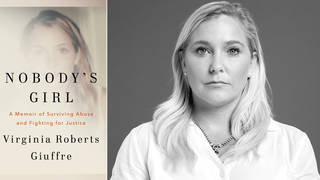
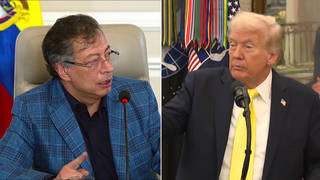
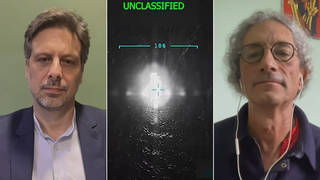
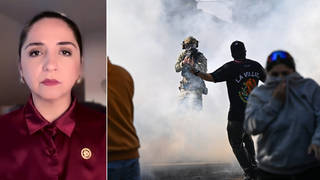






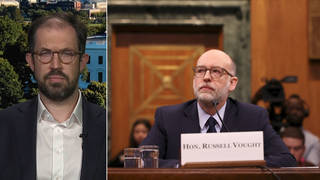
Media Options